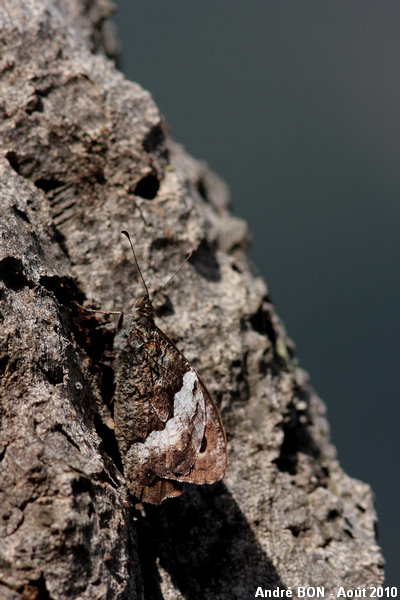
| Rock Grayling (Hipparchia alcyone (Denis & Schiffermüller, 1775)) |

|
|
Scientific name: Hipparchia alcyone (Denis & Schiffermüller, 1775) Common name: Rock Grayling Other names: Other scientific name: Hipparchia hermione. French name: Petit Sylvandre Order: Lepidoptera Suborder: Rhopalocera Family: Nymphalidae Subfamily: Satyrinae Wingspan: 52-64 mm. Biotope: Open woodlands and woodland edges, with a preference for dry, rocky and sunny places in mountain areas. Geographic area: Southern Europe, Central Europe and Eastern Europe. North Africa. In France, the Rock Grayling is only found in the eastern half of the country and in the Pyrenees. Flight time: June to August. Number of generations : 1 Caterpillar: The caterpillar has a pale brown head with dark lines. The body, which is pointed at the rear, is pale brown with darker longitudinal stripes. Host plant: Various grasses. |
The upper side of the Rock Grayling's wings is dark brown with a yellowish postdiscal band (whiter on the hind wings). The inner edge of this band is sharp. It is curved in the middle on the hind wing. The outer edge of the postdiscal band is not so sharp. There is a white-pupiled black eyespot at the apex of the fore wings. There can be another small eyespot at the middle of the submarginal area. It is sometimes missing. There is also a small eyespot on the hind wings. The underside of the hind wings is brownish black on the basal area. You can also see the whitish postdiscal band. The Rock Grayling over winters as a caterpillar at an intermediate development stage. There are similar species which are very difficult to differentiate. You can recognize the Woodland Grayling (Hipparchia fagi) by its larger size. The postdiscal band is less marked on the upper side of the fore wings and its inner edge is straighter on the upper side of the hind wings. All these points are very difficult to see in the field as this butterfly is used to landing against tree trunks with its wings closed. You can also find the Lesser Rock Grayling (Hipparchia genava) which is about the same size as the Rock Grayling. To tell these species apart you need to capture a male and press on the abdomen tip in order to count the small pointed spines of the Jullien organ. Hipparchia fagi has 2 to 4 spines, Hipparchia alcyone has 15 to 25 spines, Hipparchia genava has 7 to 15 spines. |
| [To know more about the Rock Grayling] [Top] |

|
The size of this butterfly, landed on a trunk, didn't seem very large to me. This is the only reason why I have discarded the Woodland Grayling species (Hipparchia fagi). Of course there is still a doubt with the Lesser Rock Grayling (Hipparchia genava). Hipparchia sp. would have been better! |